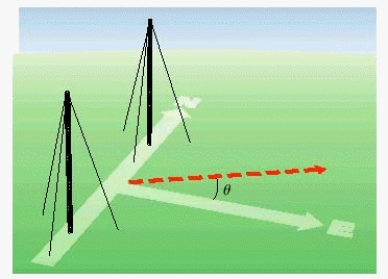Multiple Choice
Radio stations often have more than one broadcasting tower because federal guidelines do not usually permit a radio station to broadcast its signal in all directions with equal power. Since radio waves can travel over long distances, it is important to control their directional patterns so that radio stations do not interfere with one another. Suppose that a radio station has two broadcasting towers located along a north-south line, as shown in the figure. If the radio station is broadcasting at a wavelength  and the distance between the two radio towers is equal to
and the distance between the two radio towers is equal to  , then the intensity I of the signal in the direction
, then the intensity I of the signal in the direction  is given by
is given by  where I o is the maximum intensity.
where I o is the maximum intensity.  Approximate I in terms of I o for
Approximate I in terms of I o for  .
.
A) 0.055I o
B) I o
C) 0.033I o
D) 0.066I o
E) 0.044I o
Correct Answer:

Verified
Correct Answer:
Verified
Q132: Express the angle as a decimal, to
Q133: Let P ( t ) be the
Q134: Points on the terminal sides of angles
Q135: Express <img src="https://d2lvgg3v3hfg70.cloudfront.net/TB8634/.jpg" alt="Express =
Q136: Express <img src="https://d2lvgg3v3hfg70.cloudfront.net/TB8634/.jpg" alt="Express =
Q138: Scientists sometimes use the formula <img src="https://d2lvgg3v3hfg70.cloudfront.net/TB8634/.jpg"
Q139: If a circular arc of the length
Q140: Rewrite the expression in nonradical form without
Q141: The popular biorhythm theory uses the graphs
Q142: Radio stations often have more than one